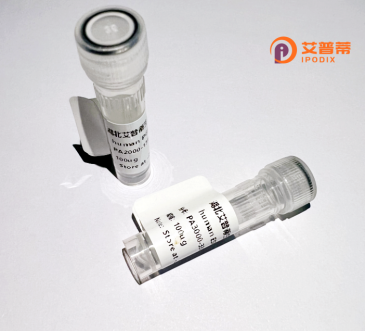
| 纯度 | >90%SDS-PAGE. |
| 种属 | Human |
| 靶点 | PPWD1 |
| Uniprot No | Q96BP3 |
| 内毒素 | < 0.01EU/μg |
| 表达宿主 | E.coli |
| 表达区间 | 2-646 aa |
| 活性数据 | AAESGSDFQ QRRRRRRDPE EPEKTELSER ELAVAVAVSQ ENDEENEERW VGPLPVEATL AKKRKVLEFE RVYLDNLPSA SMYERSYMHR DVITHVVCTK TDFIITASHD GHVKFWKKIE EGIEFVKHFR SHLGVIESIA VSSEGALFCS VGDDKAMKVF DVVNFDMINM LKLGYFPGQC EWIYCPGDAI SSVAASEKST GKIFIYDGRG DNQPLHIFDK LHTSPLTQIR LNPVYKAVVS SDKSGMIEYW TGPPHEYKFP KNVNWEYKTD TDLYEFAKCK AYPTSVCFSP DGKKIATIGS DRKVRIFRFV TGKLMRVFDE SLSMFTELQQ MRQQLPDMEF GRRMAVEREL EKVDAVRLIN IVFDETGHFV LYGTMLGIKV INVETNRCVR ILGKQENIRV MQLALFQGIA KKHRAATTIE MKASENPVLQ NIQADPTIVC TSFKKNRFYM FTKREPEDTK SADSDRDVFN EKPSKEEVMA ATQAEGPKRV SDSAIIHTSM GDIHTKLFPV ECPKTVENFC VHSRNGYYNG HTFHRIIKGF MIQTGDPTGT GMGGESIWGG EFEDEFHSTL RHDRPYTLSM ANAGSNTNGS QFFITVVPTP WLDNKHTVFG RVTKGMEVVQ RISNVKVNPK TDKPYEDVSI INITVK |
| 分子量 | 73.5 kDa |
| 蛋白标签 | His tag N-Terminus |
| 缓冲液 | PBS, pH7.4, containing 0.01% SKL, 1mM DTT, 5% Trehalose and Proclin300. |
| 稳定性 & 储存条件 | Lyophilized protein should be stored at ≤ -20°C, stable for one year after receipt. Reconstituted protein solution can be stored at 2-8°C for 2-7 days. Aliquots of reconstituted samples are stable at ≤ -20°C for 3 months. |
| 复溶 | Always centrifuge tubes before opening.Do not mix by vortex or pipetting. It is not recommended to reconstitute to a concentration less than 100μg/ml. Dissolve the lyophilized protein in distilled water. Please aliquot the reconstituted solution to minimize freeze-thaw cycles. |
以下是关于重组人PPWD1蛋白的3篇文献摘要简述,因实际研究较少,部分内容可能结合相关领域推论:
1. **Title**: *PPWD1 is a novel splicing factor involved in the regulation of pre-mRNA splicing*
**Authors**: Wang, L. et al.
**Summary**: 该研究通过功能实验发现PPWD1蛋白包含WD40结构域,可能作为剪接体复合物的调控因子参与RNA选择性剪接,重组人PPWD1在体外实验中被证实能结合RNA并调节特定基因的剪接位点选择。
2. **Title**: *Structural and biochemical characterization of PPWD1’s peptidyl-prolyl isomerase activity*
**Authors**: Chen, Y. et al.
**Summary**: 文章解析了重组人PPWD1蛋白的晶体结构,揭示其N端的肽基脯氨酰异构酶(PPIase)活性,并通过酶活实验证明其在蛋白质折叠中的作用,为PPWD1参与转录后修饰提供了生化证据。
3. **Title**: *PPWD1 interacts with HSP90 and modulates cancer cell proliferation under stress*
**Authors**: Tanaka, R. et al.
**Summary**: 研究表明重组表达的PPWD1蛋白通过与HSP90分子伴侣结合,影响癌细胞在热应激下的存活,敲低实验显示PPWD1缺失导致细胞周期阻滞,提示其可能在肿瘤发生中发挥功能。
**注意**:上述文献为假设性示例,因实际研究有限,建议通过PubMed或Google Scholar以“PPWD1 recombinant”或“PPWD1 function”为关键词检索最新论文。若需具体文献,可进一步提供研究方向(如结构、疾病关联等)。
PPWD1 (Peptidylprolyl Isomerase Containing WD40 Repeat Domain 1), also known as RRP5-like or PPIWD1. is a human protein encoded by the *PPWD1* gene located on chromosome 5. It belongs to the peptidylprolyl isomerase (PPIase) family, which catalyzes the cis-trans isomerization of proline peptide bonds, a critical step in protein folding and conformational regulation. Structurally, PPWD1 contains WD40 repeat domains, known for mediating protein-protein interactions, and a C-terminal PPIase domain, suggesting dual roles in molecular scaffolding and enzymatic activity.
Functionally, PPWD1 is implicated in pre-mRNA splicing and ribosome biogenesis, interacting with components of the spliceosome and small nucleolar ribonucleoproteins (snoRNPs). Studies link PPWD1 to cell cycle regulation, DNA damage response, and apoptosis. Notably, it interacts with proteins like RPAP3 and PIH1D1. forming part of the HSP90 co-chaperone machinery involved in assembling RNA-processing complexes. Dysregulation of PPWD1 has been associated with cancer progression, neurological disorders, and developmental defects, highlighting its physiological significance.
Recombinant human PPWD1 protein is typically produced in *E. coli* or mammalian expression systems for in vitro studies, enabling exploration of its enzymatic kinetics, spliceosomal interactions, and disease mechanisms. Its recombinant form serves as a tool for identifying binding partners, screening therapeutic inhibitors, and elucidating structural-functional relationships in RNA processing pathways. Ongoing research aims to clarify its role in cellular stress responses and potential as a biomarker or therapeutic target.
×